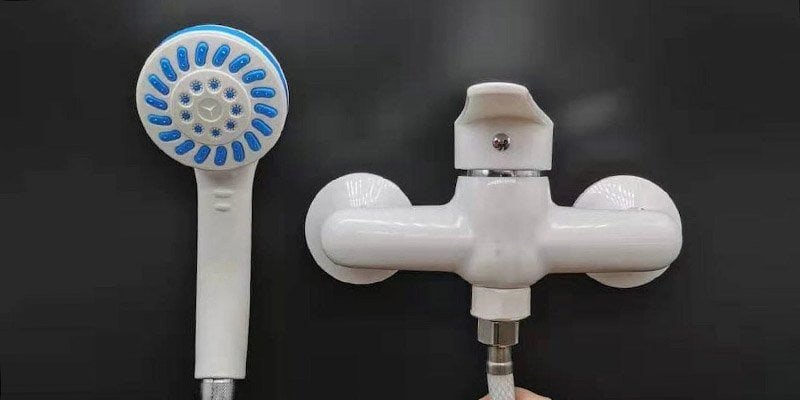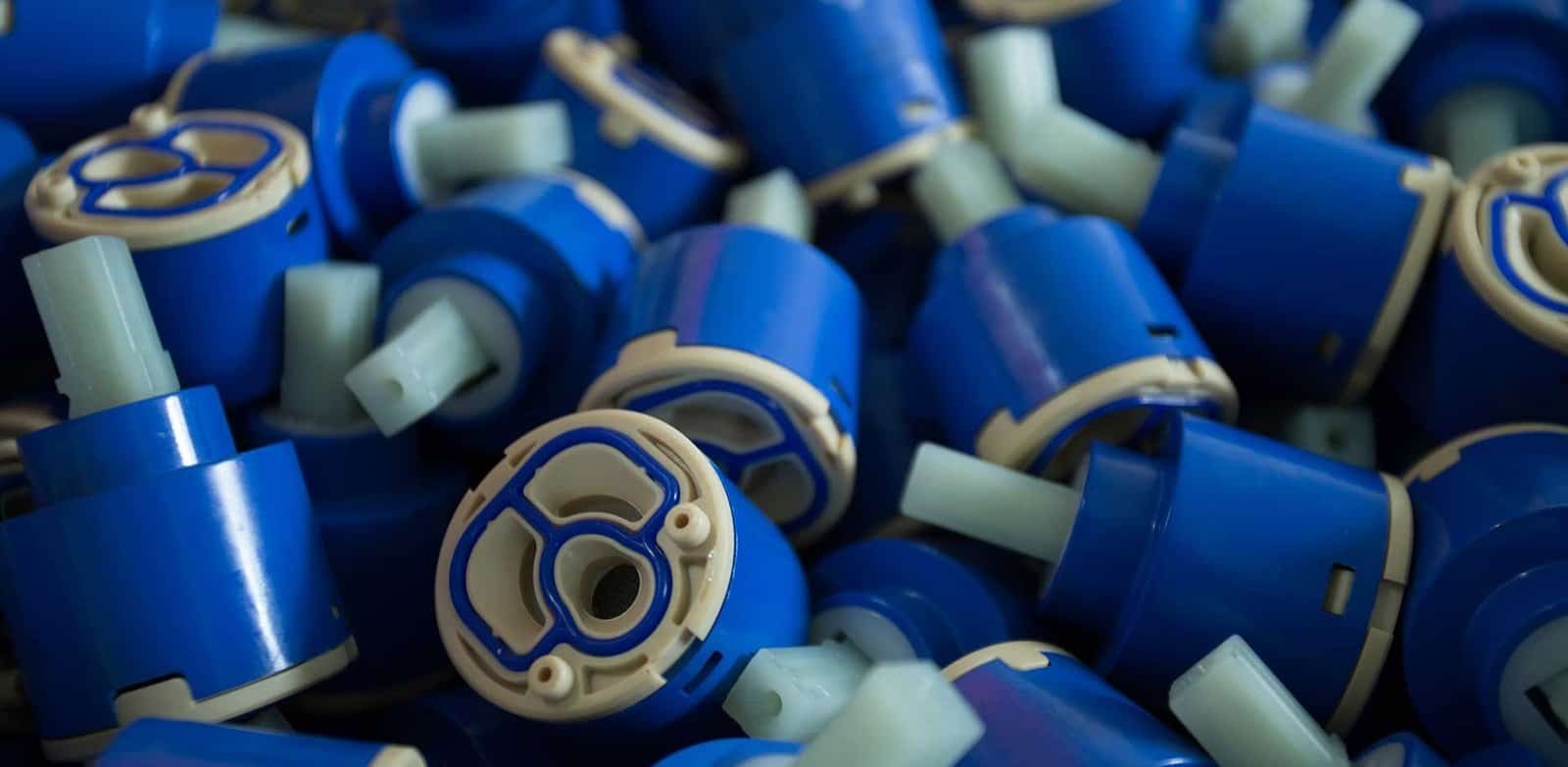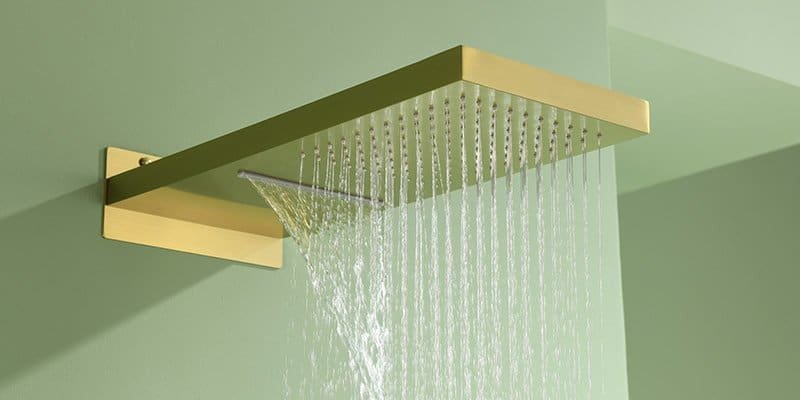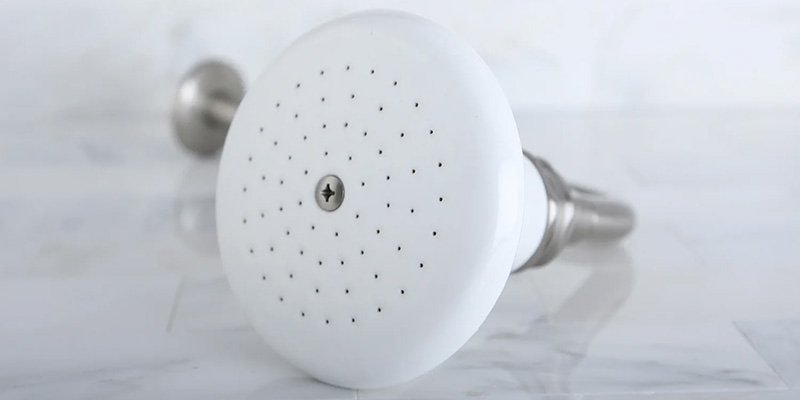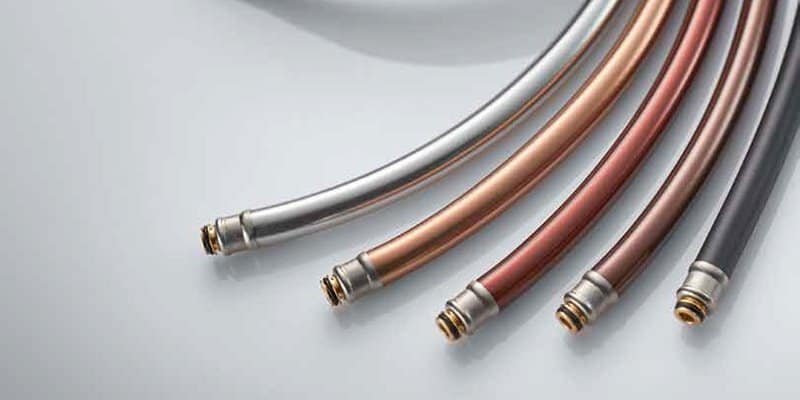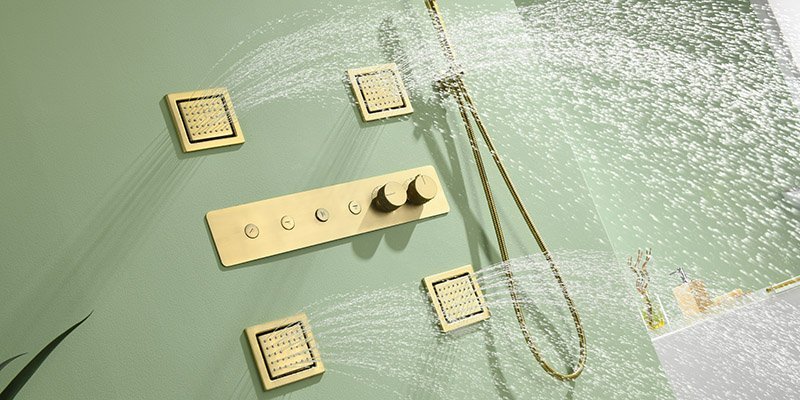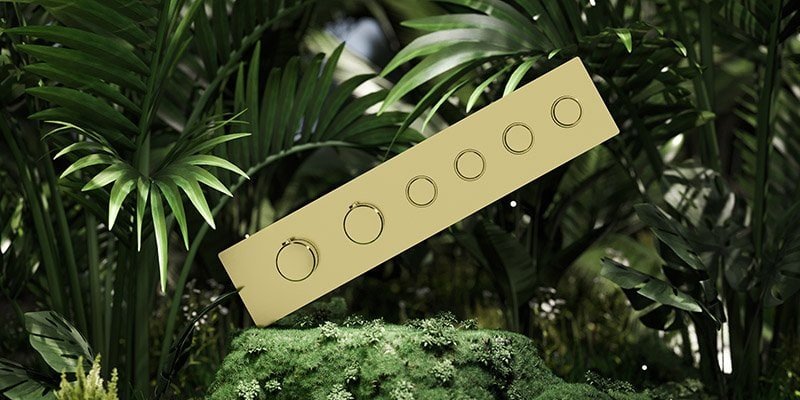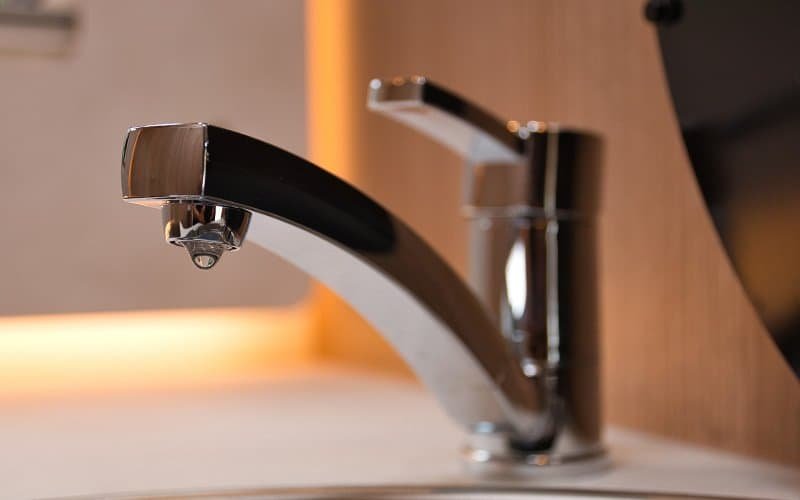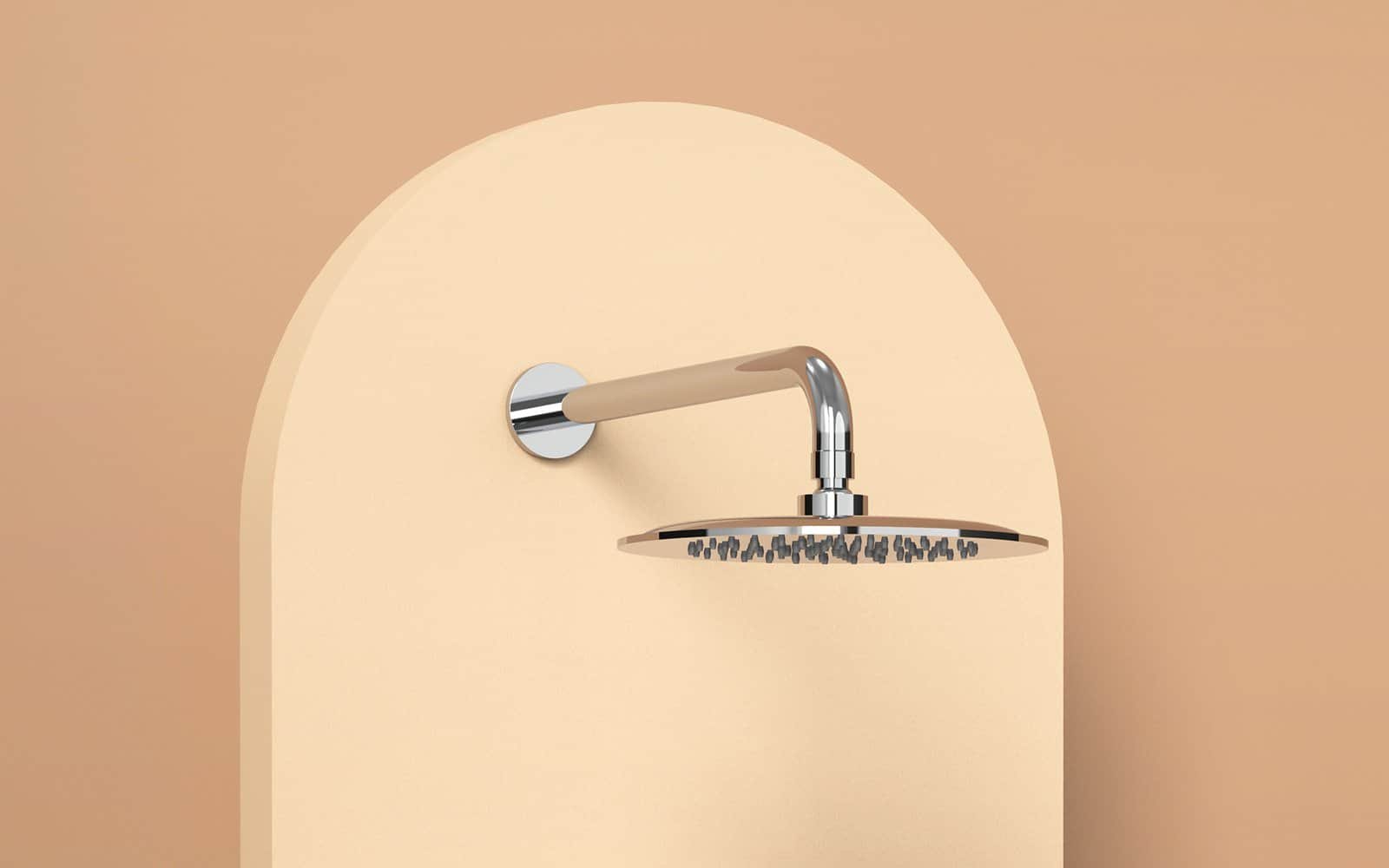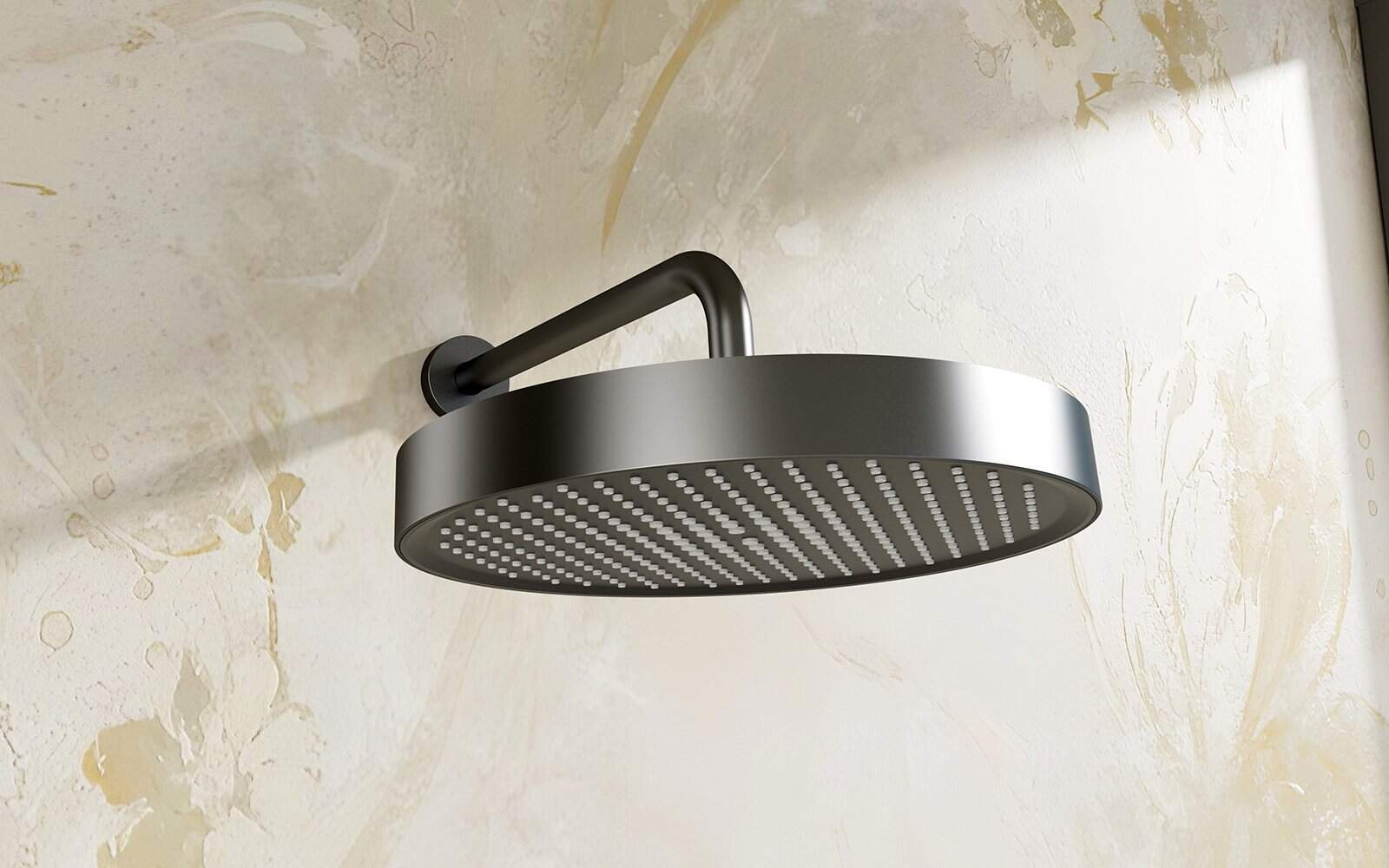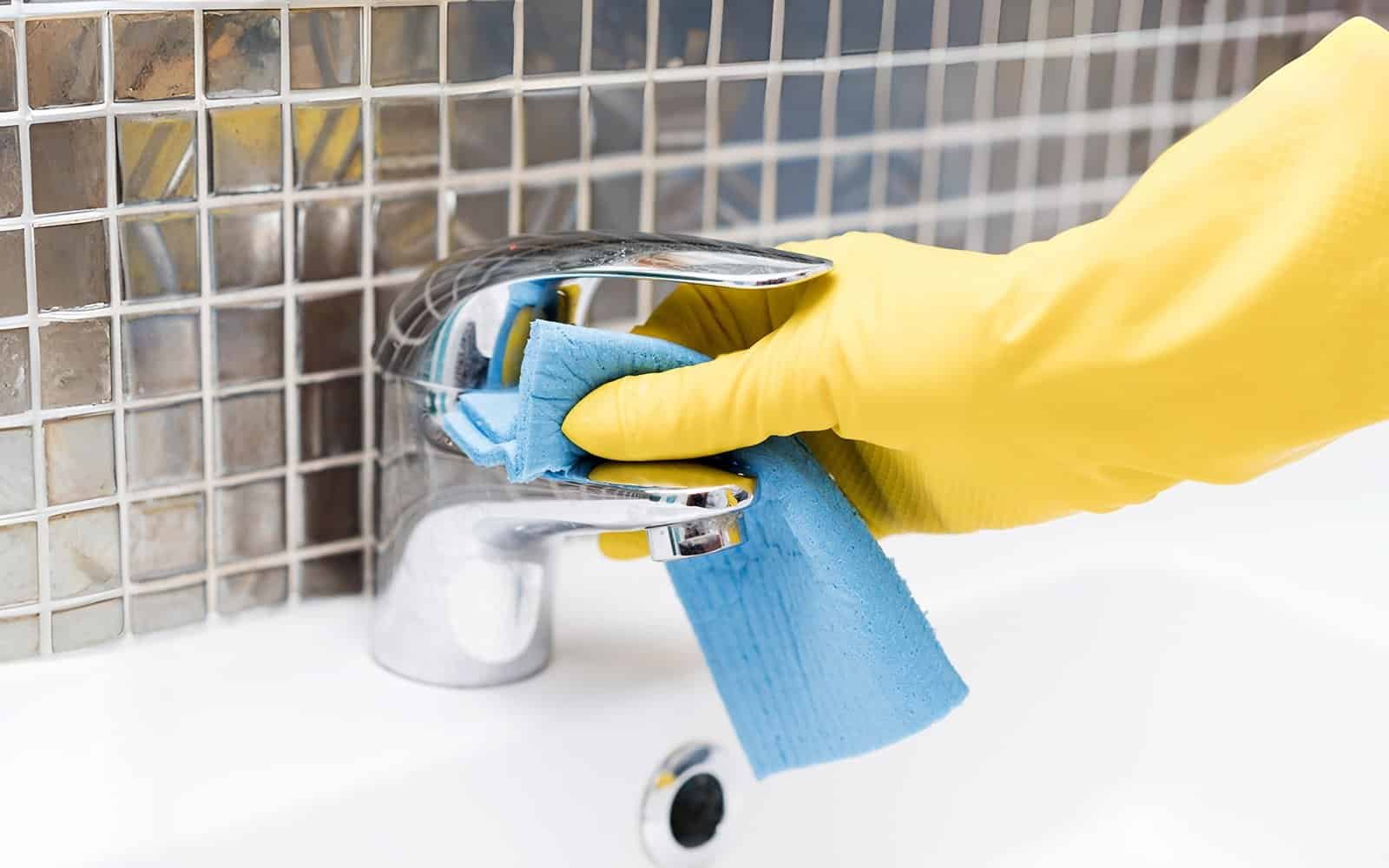Table of Content
About Rosana
Rosana offers premium faucets and shower systems that blend style, quality, and functionality.
We focus on customer satisfaction, fast delivery, and exceptional service to help you create your ideal bathroom.

Hey there! When I think about upgrading a shower system, I realize it’s not just about how pretty it looks. The material for shower systems components we choose actually makes a huge difference in how long they last, how well they work, and, honestly, how happy we’ll be with them。
Knowing what each piece is made of – from the valve hidden in the wall to the showerhead you use every day – is super important for making smart choices that fit both our needs and our style.
So, I’ve put together this guide to walk you through the common materials used in shower systems, looking at their strengths, weaknesses, and what to keep in mind. My goal is to help you pick the perfect material for shower systems
Diving Deep into Shower System Materials:
Piece by Piece
I’ve found that how well a shower system works and how long it lasts really comes down to the material for shower system parts. Let’s take a closer look at each component to understand why certain materials are often chosen and what compromises we might be making.
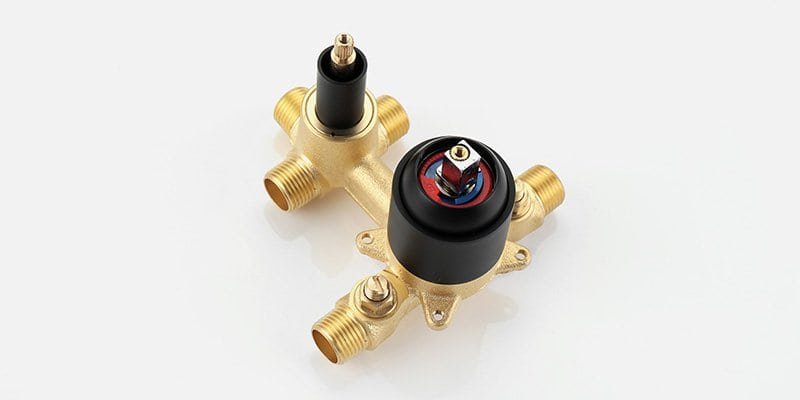
Shower Valve Materials: The Heart of Your Shower
The shower valve, which is usually tucked away behind your wall, is like the brain of your shower. It controls the water flow and temperature, so the material for shower systems components is super important for keeping things consistent, safe, and reliable for years to come.
Brass: My Go-To for Durability
From my experience, brass is consistently the most popular material for shower system valves, and for good reason! This alloy of copper and zinc is highly valued for its exceptional properties
- Exceptional strength and durability
- Remarkable resistance to corrosion and rust
- Withstands high water pressure and significant temperature fluctuations
- Excellent sealing surface for fittings, crucial for preventing leaks
- Often features a “forged brass body,” a sign of dependable use
I’ve noticed that brass continues to dominate in shower valves, even though it costs a bit more. This really highlights a key principle in plumbing: for those critical internal parts, performance and longevity are non-negotiable.
Brass’s strength, heat resistance, and ability to handle pressure directly contribute to its long-term reliability. This reliability is vital for avoiding expensive repairs and ensuring your water temperature stays consistent, thanks to those pressure-balancing features.
While there used to be concerns about lead in some older brass pipes, modern standards and good manufacturers have pretty much solved this by using lead-free brass or brass with very low lead content.
The market’s preference for reliability in these foundational plumbing components tells me that, for both us homeowners and the manufacturers, the functional benefits of brass are totally worth the initial investment.
Via. Arad Branding »
Polymer & ABS: The Budget-Friendly Options I’ve Seen
While brass is definitely the top dog, I’ve also seen shower valves, or at least parts of them, made from polymer or ABS (Acrylonitrile Butadiene Styrene) plastic. These material for shower systems offer a practical choice for budget-conscious buyers due to their characteristics:
- Generally more economical
- Lightweight
- ABS is recognized for its impressive impact resistance
- Good dimensional stability
- Good resistance to various chemicals
When I see polymer and ABS used in shower valves, despite them being less durable than brass, I know it’s usually about cost.
The main trade-off here is longevity; plastic valves simply might not last as long as brass and can be more prone to cracking or breaking, especially with high pressure or fluctuating temperatures over time.
A big limitation for hot water systems is that ABS has a “low continuous service temperature of 80°C”, which is a stark contrast to brass’s excellent heat resistance.
This choice really shows that saving money upfront can mean a shorter product life and potentially more frequent replacements down the road, especially since they’re constantly exposed to hot water
Via. Wanhai Cartridge »
Inside the Valve: Ceramic Disc vs. Metal Cartridges
Beyond the main valve body, I consider the cartridge to be a super important internal part that precisely controls your water flow and temperature. The material of this small but mighty component really affects how well your valve performs and how long it lasts.
Ceramic Disc Cartridges are, in my opinion, a superior technology for preventing drips. They function using two rotating ceramic discs that precisely align to regulate water flow. Here’s why I think they’re great:
- Exceptionally durable
- Highly resistant to scratches and wear
- Frequently last for 10 years or more
- Almost leak-proof due to tightly fitting discs
- Maintain smooth, effortless operation even after years of use
- Some advanced designs incorporate a “self-cleaning” feature 6
- Primary consideration: Higher upfront cost
Metal Cartridges represent another option, and I typically see them in more budget-friendly valve assemblies. Here’s what I’ve found about them:
- Main advantage: More “wallet-friendly” initial price
- Can be more prone to corrosion or stiffening, especially in hard water areas
- Often result in a shorter lifespan, typically ranging from 5 to 7 years
My take on choosing between ceramic disc and metal cartridges within a shower valve is that it profoundly impacts the overall lifespan and maintenance of your entire shower system.
I believe investing in ceramic discs, despite the higher initial cost, directly leads to significantly fewer leaks and a much longer life for the valve.
This ultimately saves us money and a lot of headaches in the long run. The cartridge, even though it’s a small internal part, is often called the “heart” of the faucet, and it’s under constant stress every time we use the shower handle. If it fails, we’re looking at frustrating “drippy headaches” and a “leaky shower faucet”.
So, a durable, leak-proof cartridge directly helps reduce water waste, prevents potential water damage, and cuts down on future repairs or replacements, lowering the total cost of ownership and making us happier with our shower over time.
Stainless Steel: Sleek, Strong, and Stain-Resistant – My Kind of Material!
I think stainless steel is an excellent choice for shower heads because of its robust properties.
- Highly durable
- Inherently resistant to rust, corrosion, and stains
- Low maintenance requirements and ease of cleaning
- Consistently retains its luster over time, even when exposed to extreme temperatures
- Withstands high water pressure effectively due to strength and relatively light weight
- Modern and sleek appearance, available in brushed, polished, and matte finishes
Brass: The Classic Choice for Longevity That I Trust
Just like with shower valves, brass is a premium material for shower heads, especially the high-quality ones.7 It boasts exceptional properties
- Exceptional durability
- Strong resistance to rust and corrosion
- Rarely needs replacement
- Capable of withstanding high water pressure and temperature variations
- Classic, elegant, and timeless appeal
- Primary consideration: Higher price point
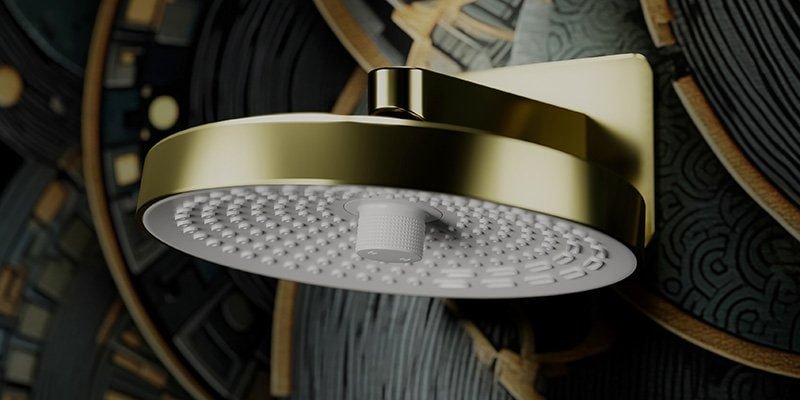
Plastic: Lightweight and Wallet-Friendly (But I’d Be Cautious)
Plastic shower heads represent the most affordable and lightweight option available, making them particularly easy to install.2 Here’s what I’ve observed about them:
- Most affordable and lightweight option
- Vast array of colors and designs
- Generally do not offer the same durability as metal
- More prone to cracking or breaking, especially under high water pressure or temperature fluctuations
- Can exhibit faster wear or fading over time
The widespread availability of plastic shower heads, despite their acknowledged lower durability and shorter lifespan compared to metal options, reflects a significant consumer segment that prioritizes immediate cost savings over long-term performance.
For us, this creates a hidden cost of ownership, because plastic units are probably going to need replacing more often.
For a part like a shower head, which we handle all the time and that’s constantly exposed to different temperatures and water quality, the material choice directly impacts our long-term satisfaction and our wallets.
This suggests that manufacturers cater to different price points by varying material quality, and I think we, as consumers, should be aware of this to avoid unexpected future expenses.
Via. K&B Distributors »
Porcelain: For a Touch of Vintage Charm (If That’s Your Vibe)
Porcelain, a ceramic material, offers a distinct aesthetic appeal for shower heads, making it an excellent choice for those aiming to create a vintage or classic look in their bathroom. This material for shower systems component is characterized by
- Distinct aesthetic appeal for vintage or classic looks
- Typically found in custom bathroom makeovers
- Can feature a complete porcelain finish or incorporate porcelain accents
- Research does not extensively detail long-term durability as a primary material for the entire shower head body 14, suggesting its role is often more about niche design and accent rather than core structural integrity.
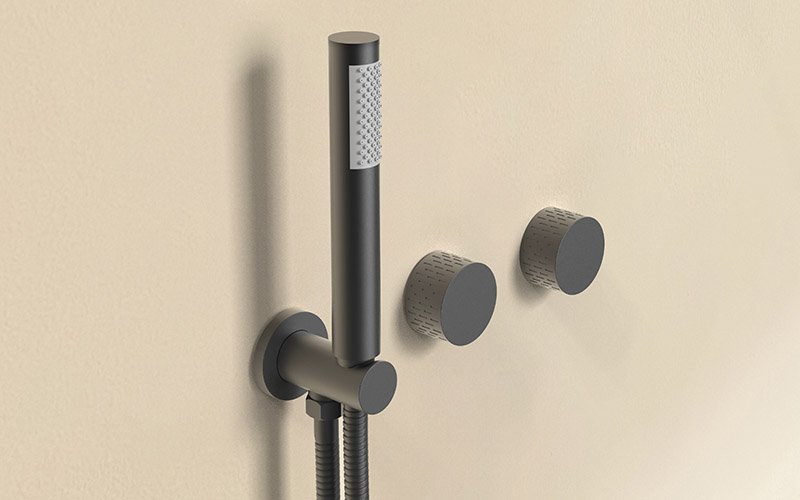
Handheld Freedom: Hand Shower Materials
Hand showers give us amazing flexibility and convenience in the shower, letting us rinse specific areas and adding a lot of functionality. The material for shower systems hand shower chosen affects both how it feels in our hand and how long it lasts.
The Usual Suspects: Stainless Steel, Brass, Plastic, ABS (And What I Look For)
- Stainless Steel:
- Durable and modern option
- Strong resistance to rust and corrosion
- Sleek appearance, available in brushed, polished, or matte finishes
- Brass:
- High-quality, durable, and corrosion-resistant
- Frequently utilized for luxury handheld shower heads
- Imparts a classic and elegant look
- Main consideration: Higher price point
- Plastic (including ABS):
- Affordable and lightweight solution
- Easy to install and maneuver
- ABS plastic is noted for its impact resistance and general durability
- Generally less durable than metal
- More prone to cracking or breaking
- May not withstand high water pressure or temperature as effectively over time
- Chrome Finish:
- Most popular surface treatment
- Provides a shiny, reflective, and versatile surface
- Effectively resists tarnishing and corrosion
- Considered durable and capable of withstanding high water pressure and temperature
- Silicone Nozzles:
- Clog-resistant properties
- Require very little maintenance
The material of the shower system’s handheld showers subtly reflects a balance between the tactile experience (weight and feel in hand) and long-term durability.
While metal options like stainless steel and brass offer superior longevity and a premium feel, the prevalence of plastic and ABS, particularly for the main body, suggests that ease of handling (being lightweight) and affordability are significant drivers for this specific component.
This indicates that for items actively manipulated by the user, comfort and initial cost can sometimes take precedence, even if it means a trade-off in ultimate lifespan
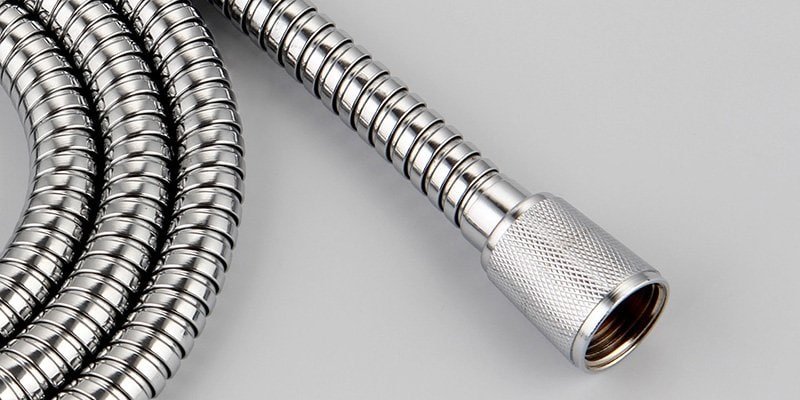
The Flexible Link: Shower Hose Materials
The shower hose is subjected to constant bending, stretching, and exposure to water, making its material for shower systems component a critical factor in preventing kinks, leaks, and premature wear.
Stainless Steel: Built to Bend and Last (My Top Pick)
I’ve found stainless steel hoses to be incredibly robust and known for their long lifespan.20 They offer excellent properties as a material for shower system hoses:
- Highly robust and long lifespan
- Exceptional resistance to rust, corrosion, and general wear
- Prevents kinks and twisting
- Scratch-resistant
- Easy to clean
- Main considerations: Heavier and more expensive than plastic alternatives
Via. Neoperl »
PVC & Reinforced Plastic: Flexible, Affordable Options (But with Caveats)
PVC (Polyvinyl Chloride) and reinforced plastic hoses are notable for being lighter, more flexible, and significantly more affordable than stainless steel options. Here’s what I’ve learned about these hoses:
- Lighter and more flexible
- Significantly more affordable
- PVC offers resistance to mold or mildew buildup
- Reinforced plastic provides enhanced strength compared to basic PVC
- Primary trade-off: Less durable than stainless steel
- More prone to cracking, degrading, or fading over time
- Basic PVC is more susceptible to twisting or bending
The material for shower systems hoses presents a clear functional trade-off between immediate flexibility and weight (offered by plastic) versus long-term kink-resistance and longevity (provided by stainless steel).
While plastic offers initial benefits in handling and cost, I’ve seen that its long-term performance in a high-wear, high-flex environment strongly favors stainless steel.
This tells me that saving money on plastic hoses upfront might lead to frustrating failures and earlier replacements. Because a shower hose is constantly bending and moving, resistance to kinking and material fatigue is paramount.
Stainless steel’s inherent strength and design (e.g., double interlock construction) directly contribute to its superior performance here, effectively preventing common issues like reduced water flow due to kinks.
On the flip side, the affordability of plastic often comes at the cost of these critical functional attributes.
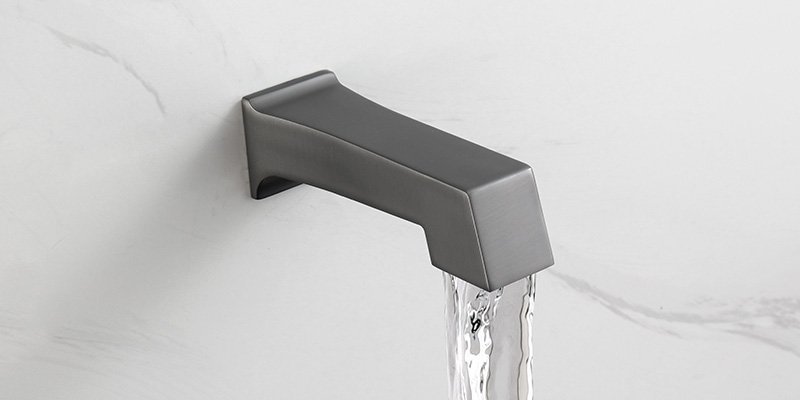
Tub Time Essential: Tub Spout Materials
The tub spout, while it seems like a simple fixture, needs to be strong enough to handle continuous water flow and occasional bumps. The tub spout we chose for it contributes to both its durability and how well it fits into the bathroom’s overall look.
Brass, Stainless Steel, and More: What I Look For
- Stainless Steel:
- Valued for its strength and resistance to rust and corrosion
- Offers a sleek, modern appearance that is easy to maintain
- Brass:
- Recognized for its durability and resistance to high water pressure
- Preferred material for shower systems connecting nipples due to its robustness
- Contributes a classic aesthetic to the fixture
- Chrome (as a finish):
- Popular for its shiny, reflective look
- Durable and resistant to tarnishing
- Easy to clean
- Galvanized Steel (historical context):
- Historically used for threaded pipes
- Modern recommendations increasingly favor brass or copper nipples to mitigate corrosion risks
The shift away from galvanized steel towards brass or copper for tub spout connections, despite galvanized steel’s perceived “durability”, highlights a critical long-term performance issue: internal corrosion.
This internal degradation, even in short lengths of pipe, can affect water quality and compromise the overall integrity of the plumbing system.
This observation indicates that the internal environment and the potential for material degradation are paramount considerations, not just external robustness.
While galvanized steel might appear externally strong, its internal chemical reactions with water, especially hard water, can lead to significant problems like clogging and lead contamination.
This demonstrates that the material for shower systems components extends beyond the visible fixture to encompass hidden connections and their long-term chemical interactions with water.
Emphasizing a trend towards more inert or self-protecting materials like brass and copper to ensure both water purity and system integrity.
Spa-Like Streams: Body Jet Materials
Body jets are luxurious additions to a shower system, designed to deliver targeted, massaging water streams for a spa-like experience. Their material for shower systems components is specifically chosen to ensure durability and consistent high performance.
Stainless Steel & Brass: Power and Performance (My Preference for Luxury)
- Inherent durability
- Strong resistance to corrosion
- Essential for components constantly exposed to water and designed to deliver high-pressure streams
- Engineered to provide an enhanced, therapeutic shower experience
- Require regular cleaning with a vinegar solution and a soft brush to prevent mineral buildup and clogging
- Using water softeners can significantly help in preventing mineral deposits
- Typically increase water consumption
- Require a more complex installation process
The exclusive use of stainless steel and brass for body jets, despite their higher cost and the overall complexity these features add to a shower system, indicates that for “luxury” or “enhanced experience” components, the material of the shower system, quality, and inherent corrosion resistance are non-negotiable.
This suggests that consumers are willing to pay a premium for features where material integrity directly impacts the intended high-end performance and longevity.
The high-performance expectation of body jets necessitates materials that can withstand constant water exposure and targeted streams without corroding or degrading.
Stainless steel and brass inherently offer this resistance, ensuring the small nozzles remain clear and functional.
Cheaper materials would likely fail quickly, leading to dissatisfaction and negating the “luxury” aspect of these features.

Adjustable Convenience: Sliding Bar Materials
A sliding bar provides the flexibility to adjust the height of a hand shower, significantly enhancing the versatility and comfort of the showering experience.
The material for shower systems sliding bar must be sturdy and resistant to the humid bathroom environment to ensure smooth operation and longevity.
Brass, Stainless Steel, and ABS: Finding Your Fit (What I’ve Seen)
Sliding bars are available in a range of materials, with metal (as a general category), brass, stainless steel, and ABS plastic being common choices
- Brass:
- Often utilized for sliding bars intended for “traditional washroom decor”
- Recognized for its overall durability
- Stainless Steel:
- Provides “durable, stainless steel construction”
- Offers strong resistance to corrosion
- Specifically mentioned for “adjustable height shower rail for improved shower flexibility”
- ABS Plastic:
- Offers a lighter and more affordable option
- Sometimes integrated with additional features like a soap dish
- These base materials are then finished in a variety of popular colors such as Matte Black, Nickel, Bronze, and Chrome, allowing for aesthetic coordination with other bathroom fixtures.
The availability of sliding bars in both robust metals (brass, stainless steel) and lighter ABS plastic highlights a design consideration where the functional stability of the bar (its ability to securely hold and adjust a shower head) is balanced against factors like cost and weight.
While metal options offer superior long-term durability and structural integrity, ABS provides a more accessible and lighter alternative. This indicates that for some components, a blend of functionality and affordability is sought.
The need for adjustability and secure holding means the sliding bar must resist bending or breaking under load, a quality where metal excels.
However, if the primary use case involves lighter adjustment and cost is a significant factor, ABS can be a viable alternative, though it may not offer the same “years of dependable use” as a forged brass body in a valve.
This demonstrates that even for seemingly simple accessories, material choices reflect a nuanced design philosophy, balancing core functionality with other considerations like ease of installation, weight, and integration with other features.
Summary Table of Materials for Shower Components
| Component | Material | Recommendation Rate |
|---|---|---|
| Shower valve | Brass | |
| Stainless steel | ||
| Ceremic components | ||
| Plastic (PVC or ABS) | ||
| Shower head | Brass | |
| Stainless Steel | ||
| Plastic (ABS Plastic) | ||
| Hand Shower | Brass | |
| Stainless Steel | ||
| Plastic (ABS Plastic) | ||
| Tub Spout | Brass | |
| Stainless Steel | ||
| Body Jets | Brass | |
| Stainless Steel | ||
| Zinc Alloy | ||
| Plastic (ABS Plastic) | ||
| Shower Pipes and Fittings | Copper | |
| PEX (Cross-linked Polyethylene) | ||
| CPVC (Chlorinated Polyvinyl Chloride) |
Beyond the Basics: Important Considerations for Your Shower System Materials
Choosing the right material for shower system extends beyond individual components; it involves a holistic understanding of how various factors interact to influence overall performance, longevity, and aesthetic appeal.
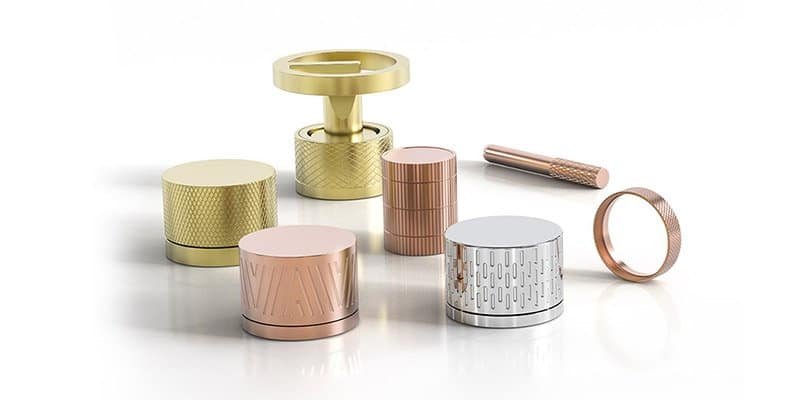
Understanding Finishes: More Than Just Looks (My Take)
The finish applied to a shower system’s components is not merely a decorative layer. It plays a significant role in the fixture’s durability, its resistance to wear and tear, and the level of maintenance required to preserve its appearance over time. This is a crucial aspect of the overall material for shower systems.
Chrome: The Ever-Popular Shine (And What I’ve Noticed)
Chrome is a perennially popular and classic choice for bathroom fixtures, offering a sleek, modern, shiny, and reflective aesthetic. Here’s what I’ve observed about this common finish:
- Sleek, modern, shiny, and reflective aesthetic
- Versatility allows it to seamlessly match most bathroom decors
- Generally durable and exhibit good resistance to tarnishing and corrosion
- When chrome plating is applied to a brass base, it enhances the underlying material’s hardness and durability
- Relatively easy to clean
- Tends to show water spots and fingerprints more readily
- Generally affordable
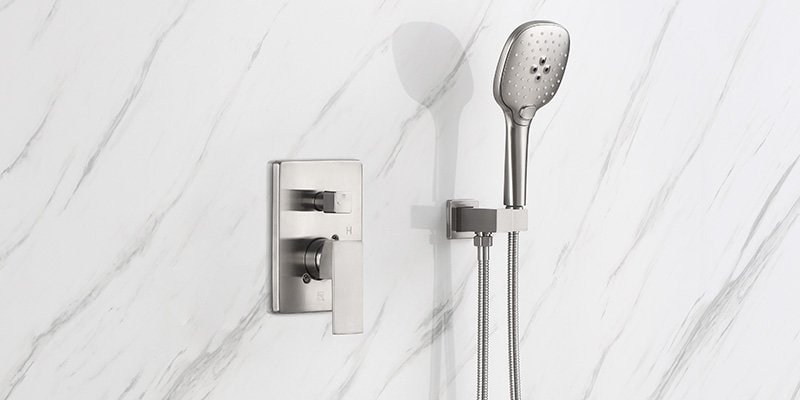
Brushed Nickel: Subtle Elegance (My Personal Favorite for Low Maintenance)
Brushed nickel offers a distinct aesthetic with a warm, matte, and subtly elegant appearance. Here’s why I think this finish is great:
- Warm, matte, and subtly elegant appearance
- Complements a wide range of bathroom styles
- Robust, resisting corrosion and tarnishing
- Tends to retain its finish longer than polished chrome
- More effective at hiding imperfections and resisting general wear and tear
- Significant advantage: Resistance to fingerprints and water spots
- Prices generally comparable to chrome, though sometimes slightly higher
Oil-Rubbed Bronze: Vintage Charm (And How I Care for It)
Oil-rubbed bronze (ORB) is a finish that provides a rich, deep brown hue with subtle black accents, specifically designed to replicate the appearance of aged bronze. Here’s what I’ve learned about this finish:
- Provides a rich, deep brown hue with subtle black accents
- Imparts warmth, elegance, and a classic, timeless aesthetic
- Engineered for durability and resistance to wear and tear
- Lifespan can vary from 5 to 20 years depending on quality and maintenance
- Effectively hides water spots and fingerprints
- Requires specific care, including periodic waxing
- Crucial to avoid harsh chemicals or abrasive cleaners
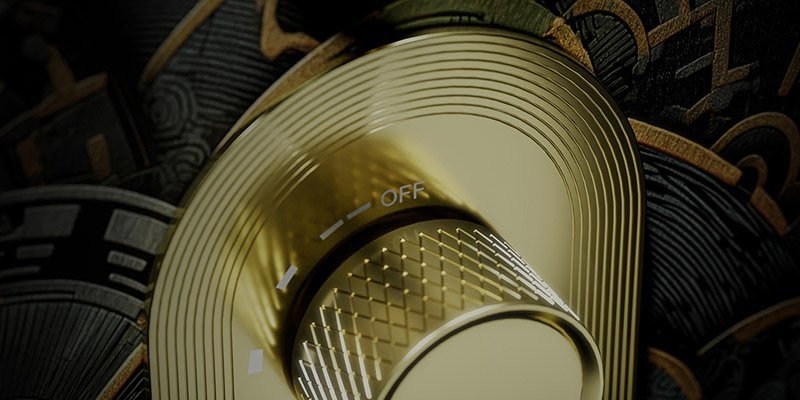
PVD Coating: The Ultimate Protector (My Top Recommendation for Longevity)
PVD (Physical Vapor Deposition) coating represents an advanced metallization process where a thin, highly durable metallic layer is applied to a surface in a vacuum environment.
This technique is applied to various base materials, including chrome, brushed, or stainless steel. Here’s why I think this coating is the best:
- Exceptional resistance: Three times higher than traditional chromium finishes and ten times more resistance to maintenance products, corrosion, and scratches
- Delivers excellent color brilliance
- Ensures the longevity of both surface texture and color
- Highly resistant to external elements such as cleaning agents and salt air
- Environmentally responsible process, producing no chemical waste
- Primary consideration: Higher cost, typically around 30% more than classic finishes
The emergence and growing adoption of PVD coating represent a significant evolution in fixture durability, moving beyond traditional electroplating to offer superior resistance to wear and tear, particularly in demanding bathroom environments.
This technology directly addresses common consumer concerns regarding tarnishing, scratching, and high maintenance, suggesting a future where a higher initial cost is increasingly justified by dramatically extended product lifespan and reduced ongoing care.
PVD’s superior resistance to cleaning agents further underscores this vulnerability in other finishes.
This demonstrates that the advanced deposition process creates an inherently tougher and more resistant surface layer, directly translating to reduced wear, less need for harsh cleaning, and a longer aesthetic life.
This trend suggests a market shift towards valuing long-term performance and reduced maintenance, even at a higher initial price point, positioning PVD coatings as a premium standard for durable, high-quality fixtures.

Other Finishes: Matte Black, Polished Brass, etc. (What I’ve Learned)
- Matte Black:
- Offers a bold, contemporary, and sleek aesthetic
- Generally durable
- Excels at hiding fingerprints and water spots better than polished chrome
- Can show dirt and dust more easily 23
- More prone to surface scratches than polished metals 31
- Lower-quality options may fade over time 31
- Maintenance requires gentle, non-abrasive cleaning methods
- Polished Brass:
- Offers a timeless appeal 8
- May necessitate more maintenance compared to other finishes to retain its luster.
- Nickel Plating on Brass:
- Provides enhanced corrosion resistance
- Increased surface hardness
Ideal choice for plumbing systems where components are exposed to corrosive water or chemicals
Common Shower System Materials at a Glance (My Summary)
| Materia | Key Pros | Key Cons | Typical Use in Shower System |
|---|---|---|---|
| Brass | Exceptional durability, high corrosion/rust resistance, superior heat/pressure handling, excellent sealing, classic aesthetic. | Higher cost, historical lead concerns (mitigated by modern standards). | Valve bodies, shower heads, hand showers, tub spouts, sliding bars. |
| Stainless Steel | Highly durable, excellent rust/corrosion/stain resistance, low maintenance, sleek modern aesthetic, withstands extreme temperatures. | Can be heavier than plastic, higher cost. | Shower heads, hand showers, shower hoses, body jets, sliding bars. |
| Plastic (ABS/PVC) | Very affordable, lightweight, flexible (hoses), wide range of designs. | Less durable, prone to cracking/breaking/fading, shorter lifespan, may not withstand high pressure/temperature as well. | Shower heads, hand showers, shower hoses, valve components, sliding bars. |
| Bronze | Durable, corrosion-resistant (as a metal), warm reddish-brown color, can develop aged patina. | Higher cost (as a metal), often used as a finish rather than pure metal. | Valve components (less common than brass), tub spouts (as a finish). |
| Copper | Good water quality, excellent thermal conductivity. | More expensive than PVC, less durable than brass (for pipes), can corrode. | Valve components (less common than brass), internal piping. |
| Zinc Alloy | Cost-efficient, durable, can be corrosion-resistant (when galvanized). | More susceptible to rust with prolonged moisture exposure, less strong than stainless steel, less aesthetically pleasing. | Sliding bars (less common for core components). |
Longevity & Lifespan: How Long Will Your Shower System Materials Last? (What I’ve Learned)
The material for shower systems components we pick directly impacts its overall lifespan, determining how long it will work perfectly before needing repairs or a full replacement.
I’ve found that a well-maintained shower system, built with quality materials, can actually last for many decades.
- Fiberglass or acrylic showers: Typically have a lifespan of 10 to 15 years. While affordable and easy to install, they generally offer a shorter lifespan and can develop stubborn yellow stains over time.
- Ceramic and porcelain tile showers: Considerably more durable, capable of lasting 20 years or more with proper care. Porcelain, being denser and less porous, offers superior stain and water resistance compared to ceramic.
- Standard shower heads: Typically last 6-8 years, though hard water can shorten this duration.
- Mixing valves: Generally last 15-20 years, but their longevity can be negatively impacted by poor water quality or irregular water pressure.
- Ceramic disc valves: Particularly known for their extended lifespan, often exceeding 10 years .
- Stainless steel hoses: Boast a “long lifespan”.
- PVC or reinforced plastic hoses: Explicitly noted as “not as durable as stainless steel”.
I’ve come to realize that the longevity of a shower system isn’t just about the initial material for shower systems choice. It’s a complex mix of material quality, your local water quality, and how consistently you maintain it.
This tells me that even if you pick inherently “durable” materials, they won’t last their maximum lifespan without actively managing your water conditions and cleaning regularly.
For instance, hard water, with its high mineral content, is a big factor that can significantly shorten the life of fixtures, showerheads, and valves by causing mineral deposits (limescale).
These deposits can clog showerheads and body jets, leading to reduced or uneven water flow, and can also speed up wear in internal components like metal cartridges.
Similarly, heavily used showers simply experience more wear and tear, potentially needing maintenance or replacement sooner.
This highlights a continuous responsibility for us homeowners beyond the initial purchase, as consistent care and, if needed, water treatment, are crucial for maximizing our investment and avoiding future problems with the components.
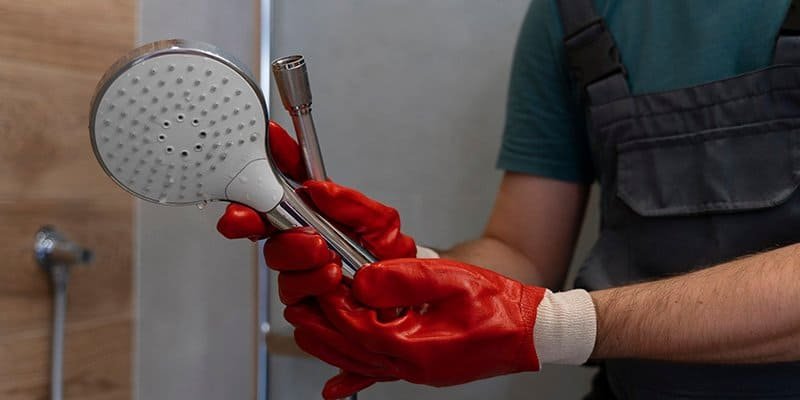
Maintenance Matters: Keeping Your Shower System Materials Sparkling
A universal rule for shower system care, in my book, is to avoid harsh chemicals and abrasive tools. Always opt for gentle, non-abrasive cleaners, mild soap solutions, and soft cloths.
Products with bleach or strong acids, as well as abrasive tools like steel wool or scrubbing pads, can cause irreversible damage to finishes and surfaces.
A simple yet highly effective habit I recommend is to wipe fixtures dry after each use, which significantly helps in preventing water spots and mineral buildup, especially if you have hard water.
Regular cleaning is key to preventing the accumulation of mineral deposits, soap scum, and other debris that can impair functionality and appearance.
- Chrome finishes, while easy to clean, show fingerprints and water spots readily, thus requiring more frequent wiping to maintain their high polish.
- Brushed Nickel excels in hiding fingerprints and water spots, making it a relatively low-maintenance option.
- Oil-Rubbed Bronze may benefit from periodic waxing to protect its unique finish and preserve its luster.
- Matte Black finishes, while resistant to fingerprints, can show dirt and dust more easily, necessitating regular wiping. It is also important to avoid cleaning products that add shine, as this will compromise the matte appearance.
- For internal components like brass pipes, occasional cleaning with vinegar and flushing with water can help prevent mineral buildup.
- Body jets require regular cleaning with a vinegar solution and a soft brush to remove mineral deposits and prevent clogging, ensuring smooth water flow.
Popular Shower Finishes: Style, Durability & Care (My Insights)
| Finish | Appearance | Durability | Maintenance Level | Cost Implication |
|---|---|---|---|---|
| Chrome | Shiny, reflective, sleek, modern. | Moderate to High (base metal dependent). | High (shows spots easily). | Affordable. |
| Brushed Nickel | Warm, matte, subtle elegance. | High. | Low (hides spots well). | Mid-range. |
| Oil-Rubbed Bronze | Dark brown, aged, rich, classic. | High (finish dependent). | Moderate (requires waxing). | Mid-range to Higher. |
| PVD Coated | Excellent color brilliance, various shades (gold, black, etc.). | Exceptional (3x chrome, 10x corrosion/scratch resistance). | Low (highly resistant to cleaners). | Higher end. |
| Matte Black | Bold, contemporary, sleek. | High (base metal dependent). | Moderate (shows dust, prone to scratches). | Higher end. |

Budget vs. Durability: Finding Your Sweet Spot for Shower System Materials
When I’m helping someone choose material for shower systems components, I often find myself balancing the initial cost with how long something will actually last.
High-end materials usually offer superior longevity and performance but come with a higher price tag. My goal is to help you find the perfect balance that fits your needs and your budget.
The cost spectrum for the material for shower systems components varies significantly
- Plastic, PVC, and basic metal cartridges are generally the most affordable options.
- Chrome and brushed nickel finishes typically fall into a mid-range price point.
- At the higher end of the spectrum are materials such as stainless steel, brass, PVD-coated finishes, and ceramic disc cartridges.
On the flip side, cheaper materials, while saving money immediately, incur these additional costs more frequently. This understanding is crucial for our decision-making, shifting the focus from just the purchase price to a more holistic view of value and long-term financial prudence when considering the material for shower systems.
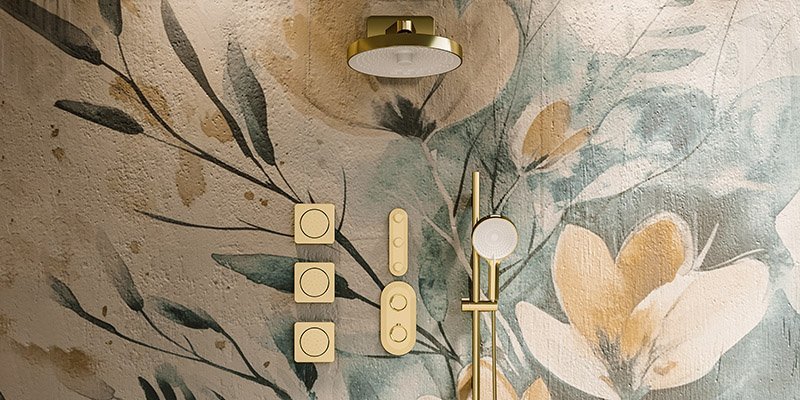
Style & Aesthetics: Matching Your Bathroom Vibe with Shower System Materials
Your shower system is a pretty prominent fixture in your bathroom, and I believe its material for shower systems and finishes play a big role in complementing the overall design aesthetic of the space.
Different materials and finishes naturally align with specific design styles.
- For a modern or sleek bathroom, chrome, stainless steel, and matte black are excellent choices, offering clean lines and contemporary appeal.
- For a vintage, classic, or traditional ambiance, brass, porcelain, and oil-rubbed bronze finishes are highly suitable, evoking a sense of timeless elegance.
- Brushed nickel provides a subtle elegance that works well in transitional and contemporary settings.
Some finishes, I’ve found, are incredibly versatile.
- Matte black, for instance, is incredibly adaptable and pairs effectively with a wide range of materials and color palettes.
- Chrome’s reflective quality allows it to mirror surrounding colors, further enhancing its versatility in diverse design schemes.
- Advanced finishes like PVD coatings can offer unique textures, particularly in brushed variants that are often hand-finished, adding a distinctive tactile dimension to the aesthetic.
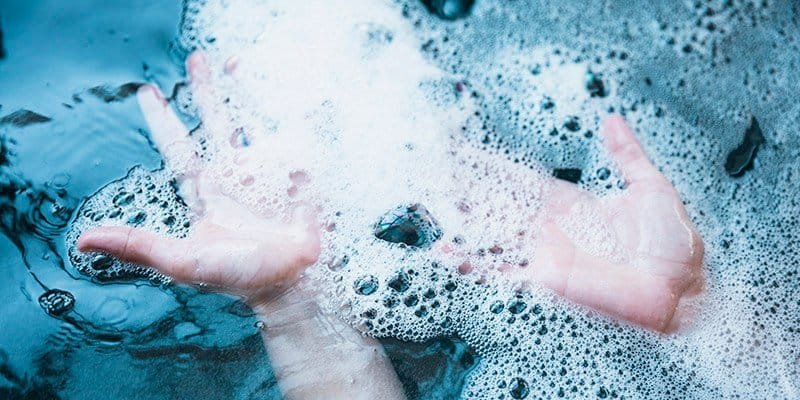
Water Quality: An Unsung Hero in Shower System Material Choice
While it’s often overlooked, I’ve found that the quality of your home’s water supply can significantly impact the long-term lifespan and performance of your shower system. This is a critical factor for the material of shower systems components.
Hard water, characterized by high concentrations of minerals like calcium, presents a major challenge. These minerals can accumulate as limescale, leading to several detrimental effects:
- Clogging of showerheads and body jets, resulting in reduced or uneven water flow
- A reduction in the overall longevity of shower fixtures and valves
- Accelerated wear in internal components, such as metal cartridges
- Visible water spots on finishes like chrome 37 or mineral buildup on matte black surfaces
Furthermore, if water remains stagnant in pipes for extended periods, certain materials can corrode, potentially leading to contamination (e.g., lead from older brass pipes).
Fortunately, solutions exist to mitigate these issues.
- Water softeners can be installed to reduce the mineral content in the water, thereby minimizing deposits and extending the system’s life
- Regular cleaning with solutions like vinegar helps to dissolve existing mineral buildup
- Selecting material for shower systems components like stainless steel, which are highly resistant to corrosion across various water conditions, can provide a more robust solution in hard water environments
Water quality significantly impacts the lifespan of shower systems. Hard water, in particular, leads to limescale buildup, damaging components, shortening product life, and increasing maintenance costs.
Therefore, understanding local water quality and investing in water treatment solutions are crucial to maximizing your shower system investment and minimizing future problems
Final Thoughts
Choosing shower system materials involves balancing durability, cost, and aesthetics. Brass and stainless steel offer the best longevity and resistance, especially for critical parts.
While plastic is affordable, it’s less durable. PVD coating provides superior finish protection, justifying its higher cost with extended lifespan.
Crucially, water quality and maintenance are key; hard water can shorten even durable materials’ lives.
An optimal system combines brass for internal components and stainless steel for visible parts, enhanced by PVD finishes and a water softener if needed, ensuring long-term performance and value.
The “best” choice for the material for shower systems is not a one-size-fits-all answer but rather a tailored decision based on specific priorities.


